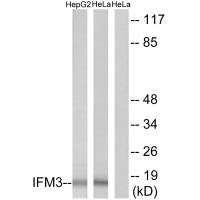
Western blot analysis of extracts from HepG2 cells and HeLa cells, using IFM3 antibody.
IFITM3 Antibody
CSB-PA083563
ApplicationsImmunoFluorescence, Western Blot, ELISA
Product group Antibodies
ReactivityHuman
TargetIFITM3
Overview
- SupplierCusabio
- Product NameIFITM3 Antibody
- Delivery Days Customer20
- ApplicationsImmunoFluorescence, Western Blot, ELISA
- CertificationResearch Use Only
- ClonalityPolyclonal
- ConjugateUnconjugated
- Gene ID10410
- Target nameIFITM3
- Target descriptioninterferon induced transmembrane protein 3
- Target synonyms1-8U; dispanin subfamily A member 2b; DSPA2b; interferon-induced transmembrane protein 3; interferon-inducible protein 1-8U; IP15
- HostRabbit
- IsotypeIgG
- Protein IDQ01628
- Protein NameInterferon-induced transmembrane protein 3
- Scientific DescriptionIFN-induced antiviral protein which disrupts intracellular cholesterol homeostasis. Inhibits the entry of viruses to the host cell cytoplasm by preventing viral fusion with cholesterol depleted endosomes. May inactivate new enveloped viruses which buds out of the infected cell, by letting them go out with a cholesterol depleted membrane. Active against multiple viruses, including influenza A virus, SARS coronavirus (SARS-CoV), Marburg virus (MARV) and Ebola virus (EBOV), Dengue virus (DNV), West Nile virus (WNV), human immunodeficiency virus type 1 (HIV-1) and vesicular stomatitis virus (VSV). Can inhibit: influenza virus hemagglutinin protein-mediated viral entry, MARV and EBOV GP1,2-mediated viral entry, SARS-CoV S protein-mediated viral entry and VSV G protein-mediated viral entry. Plays a critical role in the structural stability and function of vacuolar ATPase (v-ATPase). Establishes physical contact with the v-ATPase of endosomes which is critical for proper clathrin localization and is also required for the function of the v-ATPase to lower the pH in phagocytic endosomes thus establishing an antiviral state. Lewin A.R., Eur. J. Biochem. 199:417-423(1991). The MGC Project Team; Genome Res. 14:2121-2127(2004).
- ReactivityHuman
- Storage Instruction-20°C or -80°C
- UNSPSC12352203

